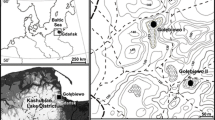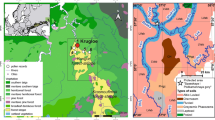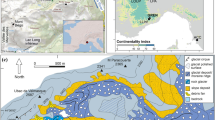Abstract
National parks are supposed to protect large-scale ecological processes, along with species and ecosystems. Detailed knowledge about past vegetation and disturbance regimes therefore forms an important basis for appropriate management. In the Bavarian Forest National Park in SE Germany, we therefore studied fossil pollen, spores and macrofossils from lake Rachelsee, a nearby mire, and Stangenfilz mire, all lying at higher elevations. Results indicate that deciduous forest on lower slopes (ca. 500–1,000 m a.s.l.) were first affected by humans in Neolithic times ca. 4500 bc with marked declines of Tilia, Ulmus and Fraxinus. High-montane mixed forests (1,000–1,450 m a.s.l.) were in a near-natural state consisting of Picea, Abies and Fagus in comparable proportions up to ca. 500 bc (a natural baseline condition), after which they were impacted by forest grazing and/or logging, starting between early-Roman times to early-Medieval times depending on location. Abies especially declined markedly. Forest partially recovered during the migration period fifth-eighth century ad, especially Carpinus, but not Abies. Subsequently, deforestation increased at lower elevation for food production, and forest grazing and wood extraction at higher elevation led to a further strong decline of Abies around ad 1000 near Rachelsee. After that, nutrient levels increased continually at all elevations, and a forest fire occurred in the 13th century near Stangenfilz. During the 19th century, forests around Rachelsee recovered partially whereas overgrazing of Stangenfilz resulted in a hiatus. Forests declined further in the 20th century around the study sites, but after ca. ad 1960 less so around Rachelsee thanks to local conservation measures. Historically recorded large-scale bark-beetle infestations following heavy storms, such as in the ad 1870s and 1980s, hardly left traces in the pollen data. From a palaeoecological perspective the Park’s no-intervention management strategy is well-suited to facilitate recovery of original forest functioning and diversity, as it is slowly leading to renewal of natural mixed forest of Abies, Picea and Fagus. This development may have considerable influence on the future disturbance regime, and the insights obtained will be important for the park management.















Similar content being viewed by others
References
Ammann B, Birks HJB, Brooks SJ et al (2000) Quantification of biotic responses to rapid climatic changes around the Younger Dryas—a synthesis. Palaeogeogr Palaeoclimatol Palaeoecol 159:313–347
Ammann B, van Leeuwen JFN, van der Knaap WO, Lischke H, Heiri O, Tinner W (2013) Vegetation responses to rapid warming and to minor climatic fluctuations during the Late-Glacial Interstadial (GI-1) at Gerzensee (Switzerland). Palaeogeogr Palaeoclimatol Palaeoecol 391:40–59
Bennett KD (1996) Determination of the number of zones in a biostratigraphical sequence. New Phytol 132:155–170
Bentz BJ, Régnière J, Fettig CJ et al (2010) Climate change and bark beetles of the western United States and Canada: direct and indirect effects. Bioscience 60:602–613
Birks HJB, Tinner W (2016) European tree dynamics and invasions during the Quaternary. In: Krumm F, Vítková L (eds) Introduced tree species in European forests: challenges and opportunities. European Forest Institute, Freiburg, pp 20–43
Blaauw M, Christen JA (2011) Flexible paleoclimate age-depth models using an autoregressive gamma process. Bayesian Anal 6:457–474
Břízová E (2011) Quillwort (Isoëtes), a mysterious plant from the Czech Republic. Acta Musei Nationalis Pragae Series B 67:25–34
Broström A, Nielsen AB, Gaillard M-J et al (2008) Pollen productivity estimates of key European plant taxa for quantitative reconstruction of past vegetation: a review. Veget Hist Archaeobot 17:461–478
Carter VA, Chiverrell RC, Clear JL et al (2018) Quantitative palynology informing conservation ecology in the bohemian/bavarian forests of Central Europe. Front Plant Sci 8:2268. https://doi.org/10.3389/fpls.2017.02268
Christensen PB, Blackmore S (1988) The Northwest European Pollen Flora, 40: Tiliaceae. Rev Palaeobot Palynol 57:33–43
Colombaroli D, Beckmann M, van der Knaap WO, Curdy P, Tinner W (2013) Changes in biodiversity and vegetation composition in the central Swiss Alps during the transition from pristine forest to first farming. Divers Distrib 19:157–170
Giesecke T, Bennett KD, Birks HJB et al (2011) The pace of Holocene vegetation change—testing for synchronous developments. Quat Sci Rev 30:2,805–2,814
Giesecke T, Brewer S, Finsinger W, Leydet M, Bradshaw RHW (2017) Patterns and dynamics of European vegetation change over the last 15,000 years. J Biogeogr 44:1,441–1,456
Goslar T, van der Knaap WO, Kamenik C, van Leeuwen JFN (2009) Free-shape 14C age-depth modelling of an intensively dated modern peat profile. J Quat Sci 24:481–499. https://doi.org/10.1002/jqs.1283
Hauner U (1980) Untersuchungen zur klimagesteuerten tertiären und quartären Morphogenese des Inneren Bayerischen Waldes (Rachel–Lusen) unter besonderer Berücksichtigung pleistozän kaltzeitlicher Formen und Ablagerungen. Regensburger Geografische Schriften 14. Institut für Geographie an der Universität Regensburg, Regensburg
Heiri O, Millet L (2005) Reconstruction of Late Glacial summer temperatures from chironomid assemblages in Lac Lautrey (Jura, France). J Quat Sci 20:33–44
Heiri O, Brooks SJ, Renssen H et al (2014) Validation of climate model-inferred regional temperature change for late-glacial Europe. Nat Commun 5:4914. https://doi.org/10.1038/ncomms5914
Heiri O, Ilyashuk B, Millet L, Samartin S, Lotter AF (2015) Stacking of discontinuous regional palaeoclimate records: chironomid-based summer temperatures from the Alpine region. Holocene 25:137–149
Henne PD, Elkin CM, Reineking B, Bugmann H, Tinner W (2011) Did soil development limit spruce (Picea abies) expansion in the Central Alps during the Holocene? Testing a palaeobotanical hypothesis with a dynamic landscape model. J Biogeogr 38:933–949
Heurich M, Englmaier KH (2010) The development of tree species composition in the Rachel-Lusen region of the Bavarian Forest National Park. Silva Gabreta 16:165–186
Heurich M, Beudert B, Rall H, Křenová Z (2010) National parks as model regions for interdisciplinary long-term ecological research: the Bavarian Forest and Šumavá National Parks underway to transboundary ecosystem research. In: Müller F, Baessler C, Schubert H, Klotz S (eds) Long-term ecological research: between theory and applications. Springer, Amsterdam, pp 327–344
Kalis AJ (1984) Forêt de la Bresse (Vogezen), vegetatiekundige en pollenanalytische onderzoekingen naar de bosgeschiedenis van een centraal-Europees middelgebergte (Forêt de la Bresse (Vosges), phytosociological and palynological investigations on the forest-history of a central-European mountain range). PhD Thesis, University of Utrecht, Utrecht (with a summary in English)
Kozáková R, Pokorný P, Peša V, Dalielisová A, Čuláková K, Svitavská Svobodová H (2015) Prehistoric human impact in the mountains of Bohemia. Do pollen and archaeological data support the traditional scenario of a prehistoric “wilderness”? Rev Palaeobot Palynol 220:29–43
Lang G (1994) Quartäre vegetationsgeschichte europas: methoden und ergebnisse. Fischer, Jena
Larocque-Tobler I, Grosjean M, Heiri O, Trachsel M, Kamenik C (2010) Thousand years of climate change reconstructed from chironomid subfossils preserved in varved lake Silvaplana, Engadine, Switzerland. Quat Sci Rev 29:1,940–1,949
Lotter AF (1999) Late-glacial and Holocene vegetation history and dynamics as shown by pollen and plant macrofossil analyses in annually laminated sediments from Soppensee, central Switzerland. Veget Hist Archaeobot 8:165–184
Lotter AF, Birks HJB, Eicher U, Hofmann W, Schwander J, Wick L (2000) Younger Dryas and Allerød summer temperatures at Gerzensee (Switzerland) inferred from fossil pollen and cladoceran assemblages. Palaeogeogr Palaeoclimatol Palaeoecol 159:349–361
Lotter AF, Heiri O, Brooks S, van Leeuwen JFN, Eicher U, Ammann B (2012) Rapid summer temperature changes during termination 1a: high-resolution multi-proxy climate reconstructions from Gerzensee (Switzerland). Quat Sci Rev 36:103–113
Lutgerink RHP, Swertz CA, Janssen CR (1989) Regional pollen assemblages versus landscape regions in the Monts du Forez, Massif Central, France. Pollen Spores 31:45–60
MacArthur RH (1957) On the relative abundance of bird species. Proc Natl Acad Sci USA 43:293–295
Marsicek J, Shuman BN, Bartlein PJ, Shafer SL, Brewer S (2018) Reconciling divergent trends and millennial variations in Holocene temperatures. Nature 554:92–96
Mazier F, Broström A, Gaillard M-J, Vittoz P, Buttler A (2008) Pollen productivity estimates and relevant source area of pollen for selected plant taxa in a pasture woodland landscape of the Jura Mountains (Switzerland). Veget Hist Archaeobot 17:479–495
Molinari C, Lehsten V, Bradshaw RHW et al (2013) Exploring potential drivers of European biomass burning over the Holocene: a data-model analysis. Glob Ecol Biogeogr 22:1,248–1,260
Morris JL, Brunelle A (2012) Pollen accumulation in lake sediments during historic spruce beetle disturbances in subalpine forests of southern Utah, USA. Holocene 22:961–974
Prentice IC (1985) Pollen representation, source area, and basin size: towards a unified theory of pollen analysis. Quat Res 23:76–86
Procháska F (2000) Šumavské šídlatky—Mýty a skutečnost: Quillwort species in the Czech Bohemian Forest (Šumava Mts)—fables and reality. Silva Gabreta 5:83–92
Reimer P, Bard E, Bayliss A et al (2013) IntCal13 and Marine13 radiocarbon age calibration curves 0–50,000 years cal BP. Radiocarbon 55:1,869–1,887
Rey F, Schwörer C, Gobet E, Colombaroli D, van Leeuwen JFN, Schleiss S, Tinner W (2013) Climatic and human impacts on mountain vegetation at Lauenensee (Bernese Alps, Switzerland) during the last 14,000 years. Holocene 23:1,415–1,427
Rey F, Gobet E, Szidat S, Lotter AF, Gilli A, Hafner A, Tinner W (2019) Radiocarbon wiggle matching on laminated sediments delivers high-precision chronologies. Radiocarbon 61:265–285
Schwörer C, Kaltenrieder P, Glur L et al (2014) Holocene climate, fire and vegetation dynamics at the treeline in the Northwestern Swiss Alps. Veget Hist Archaeobot 23:479–496
Sjögren P, van Leeuwen JFN, van der Knaap WO, van der Borg K (2006) The effect of climate variability on pollen productivity, AD 1975-2000, recorded in a Sphagnum peat hummock. Holocene 16:277–286
Sjögren P, van der Knaap WO, van Leeuwen JFN, Andrič M, Grünig A (2007) The occurrence of an upper decomposed peat layer, or “kultureller Trockenhorizont”, in the Alps and Jura Mountains. Mires and Peat 2: Article 5. http://www.mires-and-peat.net/
Sjögren P, van der Knaap WO, Kaplan J, van Leeuwen JFN, Ammann B (2008) A pilot study on pollen representation of mountain valley vegetation in the central Alps. Rev Palaeobot Palynol 149:208–218
Sjögren P, van der Knaap WO, van Leeuwen JFN (2015) Pollen dispersal properties for Poaceae and Cyperaceae: first estimates of their absolute pollen productivities. Rev Palaeobot Palynol 216:123–131
Soepboer W, Sugita S, Lotter A, van Leeuwen JFN, van der Knaap WO (2007) Pollen productivity estimates for quantitative reconstruction of vegetation cover on the Swiss Plateau. Holocene 17:65–77
Soepboer W, Sugita S, Lotter AF (2010) Regional vegetation-cover changes on the Swiss Plateau during the past two millennia: a pollen-based reconstruction using the REVEALS model. Quat Sci Rev 29:472–483
Stähli M, Finsinger W, Tinner W, Allgower B (2006) Wildfire history and fire ecology of the Swiss National Park (Central Alps): new evidence from charcoal, pollen and plant macrofossils. Holocene 16:805–817
Stalling H (1987) Untersuchungen zur spät- und postglazialen Vegetationsgeschichte im Bayerischen Wald. Dissertationes Botanicae 105. Borntraeger, Stuttgart
Stockmarr J (1971) Tablets with spores used in absolute pollen analysis. Pollen Spores 13:615–621
Szidat S, Salazar GA, Vogel E, Battaglia M, Wacker L, Synal H-A, Türler A (2014) 14C analysis and sample preparation at the new Bern Laboratory for the Analysis of Radiocarbon with AMS (LARA). Radiocarbon 56:561–566. https://doi.org/10.2458/56.17457
Tamboer-van den Heuvel G, Janssen CR (1976) Recent pollen assemblages from the crest region of the Vosges Mountains (France). Rev Palaeobot Palynol 21:219–240
Tinner W, Ammann B (2005) Long-term responses of mountain ecosystems to environmental changes: resilience, adjustment, and vulnerability. In: Huber UM, Bugmann HKM, Reasoner MA (eds) Global Change and Mountain Regions. Springer, Heidelberg, pp 133–143
Tinner W, Lotter AF (2001) Central European vegetation response to abrupt climate change at 8.2 ka. Geology 29:551–554
Tinner W, Lotter AF (2006) Holocene expansions of Fagus silvatica and Abies alba in Central Europe: where are we after eight decades of debate? Quat Sci Rev 25:526–549
Tinner W, Hubschmid P, Wehrli M, Ammann B, Conedera M (1999) Long-term forest fire ecology and dynamics in southern Switzerland. J Ecol 87:273–289
Tinner W, Conedera M, Gobet E, Hubschmid P, Wehrli M, Ammann B (2000) A palaeoecological attempt to classify fire sensitivity of trees in the southern Alps. Holocene 10:565–574
Tinner W, Conedera M, Ammann B, Lotter AF (2005) Fire ecology north and south of the Alps since the last ice age. Holocene 15:1,214–1,226
Trautmann W (1953) Zur Unterscheidung fossiler Spaltöffnungen der mitteleuropäischen Coniferen. Flora 140:523–533
Valsecchi V, Carraro G, Conedera M, Tinner W (2010) Late-Holocene vegetation and land-use dynamics in the Southern Alps (Switzerland) as a basis for nature protection and forest management. Holocene 20:483–495
Von Grafenstein U, Erlenkeuser H, Müller J, Jouzel J, Johnsen S (1998) The cold event 8200 years ago documented in oxygen isotope records of precipitation in Europe and Greenland. Clim Dyn 14:73–81
Weilner C (2016) Isoëtes im Bayerischen Wald und im Böhmerwald. Hoppea, Denkschriften der Regensburger Bototanischen Gesellschaft 77:99–112
Welten M (1982) Vegetationsgeschichtliche Untersuchungen in den westlichen Schweizer Alpen: Bern–Wallis. Denkschriften der Schweizerischen Naturforschenden Gesellschaft 95. Birkhäuser, Basel
Willis KJ, Birks HJB (2006) What is natural? The need for a long-term perspective in biodiversity conservation Science 314:1,261–1,265
Seidl R, Schelhaas MJ, Lexer MJ (2011) Unraveling the drivers of intensifying forest disturbance regimes in Europe. Glob Chang Biol 17(2):842–2,852
Zeppenfeld T, Miroslav S, DeRose J et al (2015) Response of mountain Picea abies forests to stand-replacing bark beetle outbreaks: neighbourhood effects lead to self-replacement. J Appl Ecol 52:1,402–1,411
Acknowledgements
We are grateful to Willi Tanner, Daniele Colombaroli, Carole Adolf, and Martina Bisculm for help during the coring and to Florencia Oberli for pollen sample preparation. Hans Jehl from the Bavarian Forest National Park administration helped in the organisation and logistics of the field work. The study was funded equally by the Bavarian Forest National Park, Germany, and the University of Bern, Switzerland.
Author information
Authors and Affiliations
Corresponding author
Additional information
Communicated by K.-E. Behre.
Publisher's Note
Springer Nature remains neutral with regard to jurisdictional claims in published maps and institutional affiliations.
Tanja Studer—Deceased.
Electronic supplementary material
Below is the link to the electronic supplementary material.
Rights and permissions
About this article
Cite this article
van der Knaap, W.O., van Leeuwen, J.F.N., Fahse, L. et al. Vegetation and disturbance history of the Bavarian Forest National Park, Germany. Veget Hist Archaeobot 29, 277–295 (2020). https://doi.org/10.1007/s00334-019-00742-5
Received:
Accepted:
Published:
Issue Date:
DOI: https://doi.org/10.1007/s00334-019-00742-5




